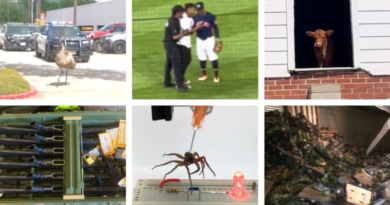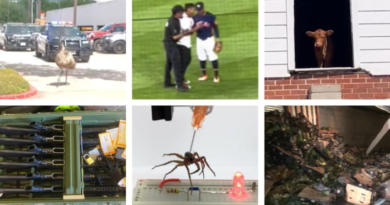Ten Odd News Stories out of New Zealand – Listverse
Jamie Frater
Head Editor
Jamie founded Listverse due to an insatiable desire to share fascinating, obscure, and bizarre facts. He has been a guest speaker on numerous national radio and television stations and is a five time published author.
New Zealand. Aotearoa. The Land Down Under. Land of the Long White Cloud. Home to hobbits, the All Blacks rugby team, where good coffee is easy to find, and the wine isn’t half bad either.
While New Zealand is my much-loved homeland, there can be some strange goings-on down this way, and here’s just a handful of oddball stories that have hit the headlines here in recent(ish) years.
Related: Top 10 Ironic Stories Of Cops Getting Themselves Arrested
Shrek the sheep gained international fame in 2004 owing to his gigantic wool fleece. Shrek had evaded shearers for six years by hiding in caves in the rugged foothills of the Central Otago region in the South Island. Merino sheep are usually shorn annually, so when Shrek was finally caught, he was immense. “He looked like some biblical creature,” explained Shrek’s owner, John Perriam, of Bendigo Hill station.
Shrek had grown a fleece weighing some 27 kilograms (60 pounds), containing roughly enough wool to make suits for 20 large men. He instantly became a national celebrity and was shorn live on television. His fleece was auctioned off to raise money for children’s medical charities. Josie Spillane of Cure Kids said that over the years, Shrek had raised more than NZ$ 150,000 (US$ 104,400) for the charity, which funds research into life-threatening childhood illnesses.
Shrek died in 2011 at the age of sixteen, with is a good old age for the Merino breed.[1]
It has been referred to as the food safety tip that echoed around the world. Police dog handler Guy Baldwin went viral back in 2009 for giving a suspected car thief some sage culinary advice regarding the safe handling of hot pastries.
Filmed in the early hours of the morning for the reality crime show Police Ten 7, the officer had pulled over a teenager suspected of driving a stolen car. The motorist claimed he was out at 3 am because he was hungry and intended to purchase a hot pie from a nearby service station. The officer’s dead-pan response went viral, providing the nation with a catchphrase that inspired T-shirts, songs, and a multitude of parody skits.
The officer asked the all-important question, “It’s three o’clock in the morning, and you’re buying a pie from the BP station. What must you always do?” The confused teenager simply had no response to that unexpected line of questioning. “That pie has been in the warming drawer for probably about 12 hours; it’ll be thermonuclear,” asserted Baldwin. “You must always blow on the pie… Always blow on the pie, safer communities together, okay.”[2]
You heard it here, folks. Always blow on the pie.
This list item combines both sheep and the police. Incredibly, it also involves sheep belonging to the police.
In 2016, four people driving a stolen Honda Integra led police on a 90-minute car chase through Shrek the sheep’s ‘hood in Central Otago. Earlier attempts to stop the car using road spikes had failed, and it was a flock of some 150 sheep being driven down the road that eventually caused the vehicle to come to a stop.
Fortunately, none of the sheep or farm dogs were injured as the car came to a halt without even attempting to drive through the flock. They were being moved by a farm worker, who was totally unfazed by the scene unfolding behind him as two men and two juveniles were taken into custody by police.
It turned out that the herd was, in fact, owned by a Queenstown police officer. “I don’t know if the local officer trained the sheep or not, but they sure did a good job in stopping that car,” a journalist on the scene later commented.[3]
In 2018, a blind, bisexual goose named Thomas was farewelled and laid to rest next to where his swan partner of nearly two decades lies. A commemorative plaque immortalized their love story by proclaiming:
” Here lies Thomas, the great-hearted goose,
Nestled near Henry, in their final roost.
Here where they raised young and found sanctuary,
Somewhere above us, great souls fly free.”
It was an enduring, complicated love story that crossed genders as well as species. Thomas the goose and Henry the swan spent 18 years together before they were joined by another swan, a female named Henrietta. The feathered polyamorous threesome raised 68 cygnets together before Henry’s death in 2009. Then, Henrietta flew off with another swan, leaving poor Thomas “heartbroken and crying for his friend.”
Thomas eventually fathered ten goslings of his own. However, they were stolen by another goose named George, who raised them as his own (George, you heartless bastard!). “You would see George and the babies, with Thomas just following them around,” a local bird-fancier recalls.
Failing eyesight saw Thomas rehomed in a bird sanctuary, where he lived out his final years eating corn and helping to raise orphaned baby swans. “He was a gentleman; he was kind to every other bird he bumped into, literally,” a staff member later commented.
When the commemorative plaque was unveiled, local Waikanae man Mik Peryer mourned that “this is the end, the love story is over.” He explained the significance of the memorial service for Thomas as being “something that needed to be done. The story touched a lot of people, particularly that he was gay.”[4]
When Hamilton couple Colin and Donna Craig-Brown discovered a behemoth potato in their veg patch weighing a whopping 7.9 kilograms (17 pounds), they felt certain that it would break the Guinness World Record for the heaviest potato.
Dubbed “Dug the Spud,” it was more than 2.8 kilograms (6 pounds) heavier than the existing Guinness record for the heaviest potato, a spud found in England in 2011. Seven months and one genetic test later, the couple received some devastating news. “Sadly, the specimen is not a potato and is, in fact, the tuber of a type of gourd. For this reason, we do unfortunately have to disqualify the application,” a Guinness World Records representative informed them.
Not even a potato, Dug was revealed to indeed be a tuber, that is, a swollen underground stem or root. The DNA testing showed that the tuber belonged to a type of gourd, a vegetable with a hard outer skin like a pumpkin. The couple was stunned by the news. “It looked like a tater, it tasted like a tater, it grew like a tater,” Colin explained. “So I figured it’s a tater.”
Dug is still currently residing in the couple’s freezer. “I say g’day to him every time I pull out some sausages. He’s a cool character,” Colin said. [5]
A lone Sitka spruce tree growing on New Zealand’s windswept, inhospitable sub-antarctic Campbell Island shouldn’t technically be there at all. The Sitka spruce is actually a species native to the northern hemisphere, but what makes this all the more remarkable is that this tree is more than 247 kilometers (170 miles) from its nearest neighbor on the Auckland Islands. This makes it the loneliest, most remote tree in the world.
Unlike Dug the “pretender” Spud, this somewhat unremarkable-looking tree is a genuine world record holder because of its isolation. The previous record-holder was the Tree of Ténéré, a well-known landmark in the heart of the Saharan Desert in Niger. The acacia tree was some 402 kilometers (250 miles) from any other tree until it was allegedly mowed down by a drunk Libyan truck driver in 1973.
The 9-meter-tall (30-foot), 100-or-so-year-old Sitka spruce was thought to have possibly been planted around the turn of the 20th century by New Zealand’s then-governor, Lord Ranfurly, while on a bird collecting expedition for the British Museum. It is suggested that he planted the conifer in the hope of transforming the island into a place of “productive forestry.”
As the spruce is apparently trapped in a juvenile state by the harsh climate and physical damage, it is unable to produce pinecones and seed, so it is likely to remain a lone sentinel at the bottom of the world.[6]
The kakapo is a large, nocturnal, flightless parrot found only in New Zealand. It is also critically endangered and was on the brink of extinction in the mid-1990s when only some 50 birds were left. However, thanks to intensive conservation efforts, a total of 210 birds were known in June 2020, all of which carry radio transmitters and are intensively monitored and carefully managed.
The most well-known kakapo is a young male named Sirocco, who rocketed to fame in 2009 after his X-rated encounter with zoologist Mark Carwardine made him a YouTube sensation. Carwardine was filming the BBC documentary series Last Chance to See with British comedian Stephen Fry. A rather frisky Sirocco attempted to energetically mate with Carwardine’s head as Fry laughingly quipped he was witnessing someone being “shagged by a rare parrot.”
Hand-raised by conservation officers due to suffering from respiratory problems, Sirocco had imprinted on humans at an early age and seemingly swore off mating with his own kind. Apparently, his unsavory rendezvous with Carwardine’s head was far from being his first, nor would it be the last.
His unorthodox rise to fame saw former Prime Minister John Key dub him the nation’s “official spokesbird for conservation.” Sirocco has since gone on annual nationwide tours as an ambassador for his species and even visited Parliament. He also promotes various wildlife conservation issues through his official Twitter and Facebook accounts.[7].jpg?20170903003335)
Photo credit: Wikimedia Commons
In March 2018, a group of jogging students made a bizarre discovery on Wellington’s Mt. Victoria lookout—a massive dumping of…freshly cooked pasta.
Students Jack Anderson, Elleana Dumper (ironic name), Tobias Leman, and Flynn Beeman were on an early morning run. They came across the pasta on top of Summit Rock, at the lookout point boasting panoramic views of the city and harbor, just before 9 am.
Wellington City Council said they had, in fact, received numerous reports about the mysterious pasta vandalism. “Our contact center logged the incident after it left a bad taste in their mouth, and the cleaning crew was dispatched to deal with spaghetti junction,” a council spokeswoman said. “The public health team said they don’t recommend anyone eating spaghetti on the rocks,” she added.
The local park rangers couldn’t recall seeing a mass food dumping like this before and added that it made a nice change from the hazardous dumping of cars, TVs, and fridges that the clean-up crews usually have to deal with.
The source (sauce???) of the pasta at the popular tourist spot was never discovered.[8]
Photo credit: Wikimedia Commons
Prostitutes in New Zealand’s largest city Auckland were accused in 2012 of destroying street signs by dancing and swinging from the roadside poles in order to entice potential customers.
Local resident Donna Lee explained how prostitutes use them as dancing poles. “The poles are part of their soliciting equipment, and they often snap them. Some of the prostitutes are big, strong people.” She claimed more than 40 signs had either been bent or broken over an 18-month period.
At the time, local Mayor Len Brown stated, “there is no doubt that the street sex trade is enjoying its unrestricted use of public space and is possibly the only industry in New Zealand to enjoy such status.” He added that other industries have to acquire licenses or receive special authority while street prostitution “faces no such constraints.”
Residents in the area hoped that bringing attention to the issue would put pressure on the government to allow Auckland Council to outlaw sex workers from certain areas. A spokesperson from the Prostitutes Collective said that banning prostitutes from popular streets would be counter-productive. “They’ll be expected to pay a fine which they can’t pay. They’ll go to court, then they have to come back onto the streets and work to pay them off. It’s just going to clog up our justice system,” said Prostitute Collective Auckland spokeswoman Annah Pickering.[9]
Photo credit: WIkimedia Commons
Also in 2018, KFC fries and warm bread rolls were used by emergency services to corral a large pig on the loose in the Waikato town of Waihi.
Estimated to weigh some 150 kilograms (331 pounds), the hefty hog casually trotted down one of the small town’s main streets with police in hot pursuit at its heels. “We got into a pursuit with a pig,” Waihi police Constable Harley North later explained.
At the time, North was unable to say how the swine got loose, believing it was likely someone’s pet that had broken out for a night on the town. Using finger-licking good bribes, the pig was eventually corralled into a makeshift pen at a local church. “The pig was left to contemplate his sinful behavior,” North said.
Later the pig was spotted being escorted by a “tall, dark stranger” down the Waihi street. The pig turned out to be a brazen boar named Bess. Just over a week later, he did another runner and was found chowing down on an orange tree. He was coerced back home by the embarrassed owner carrying a big bucket full of tasty treats.
Bess apparently got a stern telling off from the local police, who said they were considering fitting Bess with an ankle bracelet and imposing a strict curfew.[10]




